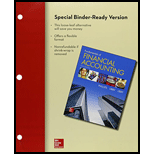
Loose-leaf for Fundamentals of Financial Accounting with Connect
5th Edition
ISBN: 9781259619007
Author: Fred Phillips Associate Professor
Publisher: McGraw-Hill Education
expand_more
expand_more
format_list_bulleted
Textbook Question
Chapter 13, Problem 13.5PB
Interpreting Profitability, Liquidity, Solvency, and P/E Ratios
Mattel and Hasbro are the two biggest makers of games and toys in the world. Mattel sells over $6 billion of products each year while annual sales of Hasbro products exceed $4 billion. Compare the two companies as a potential investment based on the following ratios:
| Ratio | Mattel | Hasbro |
| Gross profit percentage | 53.7% | 58.1% |
| Net profit margin | 13.9% | 10.0% |
| Return on equity | 28.4% | 18.0% |
| EPS | $2.59 | $2.16 |
| Receivables turnover ratio | 5.2 | 3.8 |
| Inventory turnover ratio | 5.8 | 5.0 |
| 3.22 | 1.82 | |
| Debt-to-assets | 0.25 | 0.32 |
| P/E ratio | 15.4 | 25.6 |
Required:
- 1. Which company appears more profitable? Describe the ratio(s) that you used to reach this decision.
- 2. Which company appears more liquid? Describe the ratio(s) that you used to reach this decision.
- 3. Which company appears more solvent? Describe the ratio(s) that you used to reach this decision.
- 4. Are the conclusions from your analyses in requirements 1–3 consistent with the value of the two companies, as suggested by their P/E ratios? If not, offer one explanation for any apparent inconsistency.
Expert Solution & Answer
Want to see the full answer?
Check out a sample textbook solution
Students have asked these similar questions
Gross margin solve this accounting questions
What is the balance of current liabilities on the firm's balance sheet
how much is the net income for the year using the CVP approach?
Chapter 13 Solutions
Loose-leaf for Fundamentals of Financial Accounting with Connect
Ch. 13 - What is the general goal of trend analysis?Ch. 13 - Prob. 2QCh. 13 - What is ratio analysis? Why is it useful?Ch. 13 - What benchmarks are commonly used for interpreting...Ch. 13 - Prob. 5QCh. 13 - Prob. 6QCh. 13 - Slow Cellars current ratio increased from 1.2 to...Ch. 13 - From last year to this year, Colossal Companys...Ch. 13 - From last year to this year, Berry Bam reported...Ch. 13 - Explain whether the following situations, taken...
Ch. 13 - What are the two essential characteristics of...Ch. 13 - Prob. 12QCh. 13 - Prob. 13QCh. 13 - Prob. 14QCh. 13 - Prob. 15QCh. 13 - Prob. 16QCh. 13 - 1. Which of the following ratios is not used to...Ch. 13 - Prob. 2MCCh. 13 - Prob. 3MCCh. 13 - Analysts use ratios to a. Compare different...Ch. 13 - Which of the following ratios incorporates stock...Ch. 13 - Prob. 6MCCh. 13 - Prob. 7MCCh. 13 - A bank is least likely to use which of the...Ch. 13 - Prob. 9MCCh. 13 - (Supplement 13A) Which of the following items is...Ch. 13 - Calculations for Horizontal Analyses Using the...Ch. 13 - Calculations for Vertical Analyses Refer to M13-1....Ch. 13 - Interpreting Horizontal Analyses Refer to the...Ch. 13 - Interpreting Vertical Analyses Refer to the...Ch. 13 - Prob. 13.5MECh. 13 - Prob. 13.6MECh. 13 - Prob. 13.7MECh. 13 - Analyzing the Inventory Turnover Ratio A...Ch. 13 - Inferring Financial Information Using the Current...Ch. 13 - Prob. 13.10MECh. 13 - Identifying Relevant Ratios Identify the ratio...Ch. 13 - Prob. 13.12MECh. 13 - Analyzing the Impact of Accounting Alternatives...Ch. 13 - Describing the Effect of Accounting Decisions on...Ch. 13 - Prob. 13.1ECh. 13 - Prob. 13.2ECh. 13 - Prob. 13.3ECh. 13 - Computing Profitability Ratios Use the information...Ch. 13 - Prob. 13.5ECh. 13 - Matching Each Ratio with Its Computational Formula...Ch. 13 - Computing and Interpreting Selected Liquidity...Ch. 13 - Prob. 13.8ECh. 13 - Prob. 13.9ECh. 13 - Prob. 13.10ECh. 13 - Prob. 13.11ECh. 13 - Prob. 13.12ECh. 13 - Prob. 13.13ECh. 13 - Prob. 13.14ECh. 13 - Analyzing the Impact of Alternative Inventory...Ch. 13 - Prob. 13.1CPCh. 13 - Analyzing Comparative Financial Statements Using...Ch. 13 - Prob. 13.3CPCh. 13 - Prob. 13.4CPCh. 13 - Prob. 13.5CPCh. 13 - Prob. 13.6CPCh. 13 - Prob. 13.7CPCh. 13 - Prob. 13.1PACh. 13 - Analyzing Comparative Financial Statements Using...Ch. 13 - Prob. 13.3PACh. 13 - Prob. 13.4PACh. 13 - Interpreting Profitability, Liquidity, Solvency,...Ch. 13 - Using Ratios to Compare Loan Requests from Two...Ch. 13 - Prob. 13.7PACh. 13 - Prob. 13.1PBCh. 13 - Prob. 13.2PBCh. 13 - Prob. 13.3PBCh. 13 - Prob. 13.4PBCh. 13 - Interpreting Profitability, Liquidity, Solvency,...Ch. 13 - Using Ratios to Compare Loan Requests from Two...Ch. 13 - Prob. 13.7PBCh. 13 - Prob. 13.1SDCCh. 13 - Prob. 13.2SDCCh. 13 - Prob. 13.5SDCCh. 13 - Prob. 13.6SDCCh. 13 - Prob. 13.7SDCCh. 13 - Prob. 13.1CC
Knowledge Booster
Learn more about
Need a deep-dive on the concept behind this application? Look no further. Learn more about this topic, accounting and related others by exploring similar questions and additional content below.Similar questions
arrow_back_ios
SEE MORE QUESTIONS
arrow_forward_ios
Recommended textbooks for you
 Managerial AccountingAccountingISBN:9781337912020Author:Carl Warren, Ph.d. Cma William B. TaylerPublisher:South-Western College Pub
Managerial AccountingAccountingISBN:9781337912020Author:Carl Warren, Ph.d. Cma William B. TaylerPublisher:South-Western College Pub



Managerial Accounting
Accounting
ISBN:9781337912020
Author:Carl Warren, Ph.d. Cma William B. Tayler
Publisher:South-Western College Pub
Profitability index; Author: The Finance Storyteller;https://www.youtube.com/watch?v=Md5ocNqKHq8;License: Standard Youtube License